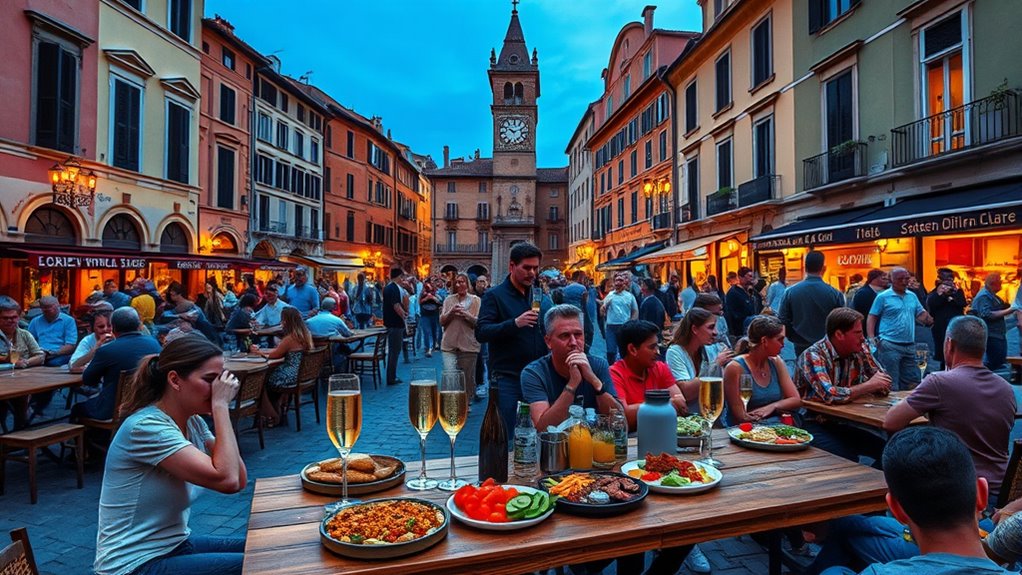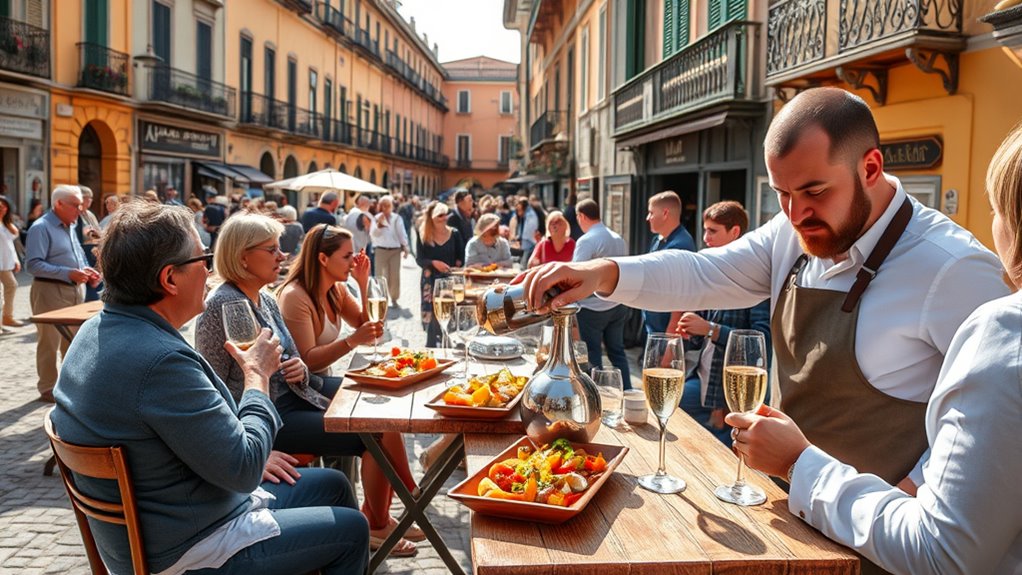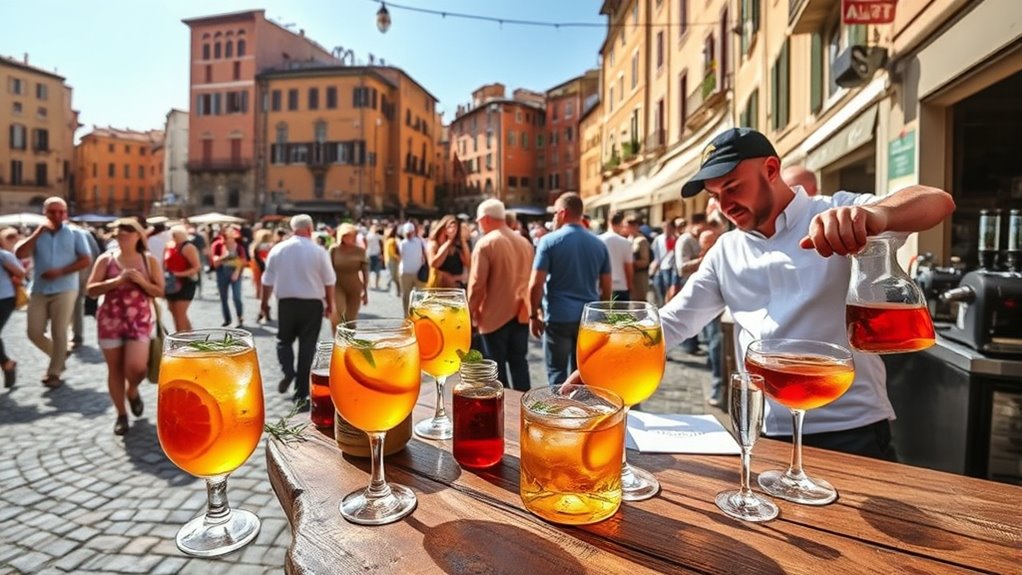To navigate Italian aperitivo culture on the road, arrive early in the evening, around 6 or 7 pm, and watch local cues for the perfect moment to join in. Order popular drinks like Aperol Spritz or Negroni and pair them with regional snacks such as olives, cured meats, or seafood. Respect local customs, observe etiquette, and choose spots away from tourist crowds for authentic experiences. Staying mindful of regional differences and social norms will deepen your enjoyment as you embrace Italy’s vibrant aperitivo scene.
Key Takeaways
- Observe local timing cues and start your aperitivo session between 6-9 pm, adjusting for regional differences.
- Follow regional customs by choosing typical drinks and snacks, such as spritzes in the North or hearty bites in the South.
- Dress smart casual and behave politely, respecting local etiquette like proper toast practices and tipping norms.
- Seek out authentic, non-touristy venues to experience genuine aperitivo traditions and regional flavors.
- Engage with staff and locals for recommendations, embracing seasonal ingredients and regional specialties for an authentic experience.
Understanding the Origins and Significance of Aperitivo in Italy

Have you ever wondered where the tradition of aperitivo began and why it holds such importance in Italy? The history significance of aperitivo traces back to centuries ago when it became a social ritual, blending relaxation with community. Its cultural roots are deeply embedded in Italian life, serving as a pre-meal tradition that encourages conversation and connection. Originally, it was a practical way to whet the appetite with small drinks and snacks before dinner, but over time, it transformed into a cherished social custom. Today, aperitivo symbolizes more than just a drink; it embodies Italy’s appreciation for leisure and togetherness. Recognizing its origins helps you understand why this tradition remains essential to Italian culture, creating a welcoming atmosphere that invites locals and visitors alike.
Recognizing the Typical Timeframes for Aperitivo Hours

In Italy, the aperitivo hours typically fall in the late afternoon to early evening, creating a smooth shift between work and dinner. Recognizing these typical timeframes requires an understanding of cultural nuances and timing etiquette. Usually, aperitivo begins around 6 or 7 pm and can last until 9 pm, though this varies by region. In northern cities like Milan, you might find aperitivo starting earlier, while in southern areas, it could be slightly later. Paying attention to local cues and observing when locals settle into bars helps you align with the unwritten social timing. Respecting the typical timeframe shows cultural awareness and ensures you enjoy the experience in a manner consistent with local customs. Additionally, understanding the traditional setting of aperitivo—such as bars, piazzas, or enotecas—can enhance your appreciation of the culture. Being aware of the soundscape during these hours, including background chatter, clinking glasses, and ambient music, can further enrich your experience. Recognizing the social atmosphere during aperitivo hours also allows you to connect more genuinely with local customs and fellow patrons. Moreover, becoming familiar with the local customs related to ordering and socializing during aperitivo can help you participate more comfortably and authentically. Observing the pace of social interactions during these hours can also provide insight into regional variations and local etiquette.
Exploring Popular Aperitivo Drinks and How to Order Them

During aperitivo hour, selecting the right drink is essential to embracing Italian social customs. You’ll notice a mix of traditional choices and craft cocktail trends, reflecting Italy’s evolving palate. Classic options like Aperol Spritz, Negroni, and Campari soda are popular, and ordering is straightforward—simply ask for your preferred drink by name. If you prefer non-alcoholic options, many bars now offer sophisticated mocktails, sparkling waters, or fresh fruit juices, allowing everyone to join in the convivial atmosphere. When ordering, you can specify your preference or ask for the bartender’s recommendation. Remember, aperitivo is as much about the social experience as the drink itself, so enjoy the moment and the lively ambiance around you. Using tea accessories and merchandise can even add a touch of elegance to your own aperitivo setup if you’re hosting at home. Incorporating specialty teas can also elevate your gathering with unique flavors and aromas.
Navigating the Selection of Snack Platters and Light Bites

Selecting the choice of snack platters and light bites is key to fully enjoying Italian aperitivo. You’ll find cheese platters featuring a variety of regional cheeses, from creamy mozzarella to sharp pecorino, which pair perfectly with your drinks. Finger foods like bruschetta, olives, marinated vegetables, and cured meats are common, offering a satisfying mix of flavors and textures. When choosing, consider balance: a mix of savory, salty, and slightly tangy options enhances your experience. Keep in mind that many bars serve small, shared plates, encouraging socializing. Don’t hesitate to ask staff for recommendations or to try local specialties. Remember, the goal is to nibble and sip, enjoying the flavors while soaking in the lively atmosphere. Incorporating regional food specialties into your selection can also deepen your appreciation of local culinary traditions. Exploring local culinary traditions through regional ingredients and preparation methods can enrich your experience. To truly immerse yourself, exploring historic farmhouses and heritage tours nearby can provide additional context about regional gastronomy and history. Additionally, seeking out local markets can give you fresh, authentic ingredients to enhance your aperitivo experience. Incorporating spiritual decor elements into your surroundings can also create a more mindful and relaxing social atmosphere.
Identifying the Best Local Spots for an Authentic Experience

To find truly authentic aperitivo spots, keep an eye out for hidden gems tucked away from tourist crowds. Seasonal aperitivo spots also offer fresh, local experiences that change with the time of year. Exploring these options guarantees you enjoy a genuine taste of Italian culture. Additionally, understanding local customs and traditions can help you discreetly gather information on lesser-known venues frequented by locals. Recognizing cultural cues and signs can also deepen your awareness of subtle signals from the environment that guide you to authentic experiences. Being aware of Fokos insights can further enhance your exploration of local venues and traditions.
Hidden Gems in Town
Some of the most authentic aperitivo experiences can be found in hidden spots that many tourists overlook. These places often serve exceptional local wine and are nestled within historic venues, offering a true taste of Italy’s rich culture. Discovering these gems allows you to connect with the city’s soul, away from crowded tourist spots. Picture sipping a glass of local wine in a centuries-old courtyard or enjoying bites in a tucked-away cellar. These intimate settings evoke emotion and create memorable moments. Below is a list of such hidden treasures:
| Venue Type | Unique Feature |
|---|---|
| Offbeat Wine Bar | Authentic local wine |
| Secret Courtyard | Historic charm |
| Underground Cellar | Intimate atmosphere |
| Old Town Tavern | Traditional ambiance |
| Hidden Lounge | Surprising cozy vibe |
Additionally, these venues often feature local traditions, enhancing your cultural experience.
Seasonal Aperitivo Spots
As the seasons change, so do the offerings at Italy’s best aperitivo spots, making it essential to seek out places that highlight seasonal ingredients and regional specialties. In spring, look for spots serving dishes with fresh asparagus, peas, and artichokes, capturing the vibrant flavors of the season. During summer, enjoy lighter bites featuring ripe tomatoes, basil, and seafood, perfect for the warm weather. Autumn brings hearty ingredients like mushrooms, pumpkins, and chestnuts, often showcased in warm appetizers. In winter, cozy up with spots offering cured meats, cheeses, and root vegetables. By choosing venues that emphasize local flavors and seasonal ingredients, you’ll enjoy an authentic aperitivo experience that truly reflects Italy’s regional culinary traditions. Incorporating seasonal themes into your selection can further enhance your cultural immersion. Understanding the importance of natural techniques in local food preparation can deepen your appreciation for regional culinary practices, making your experience even more authentic. Exploring regional culinary traditions can help you appreciate the diverse gastronomic heritage across Italy’s regions. Paying attention to local sourcing can ensure fresher ingredients and a more genuine taste experience. Additionally, visiting spots that prioritize sustainable practices can contribute to supporting local communities and preserving traditional methods.
Observing and Respecting Local Customs and Etiquette

When enjoying aperitivo in Italy, you should dress smartly to match the local atmosphere. Be mindful of drinking customs, such as limiting shots or pacing your drinks, and always respect social rituals like greeting others or waiting your turn. Observing these customs shows appreciation for Italian culture and helps you blend in seamlessly.
Dress Appropriately for Aperitivo
To truly embrace the Italian aperitivo culture, dressing appropriately is essential because it shows respect for local customs and helps you blend seamlessly into the social setting. Pay attention to fashion tips that emphasize smart casual attire—think neat shirts, stylish blouses, or well-fitted trousers. While the dress code is generally relaxed, avoid overly casual or athletic wear, as it can seem disrespectful. Italians appreciate polished, elegant style even in casual settings, so opt for refined but comfortable outfits. Accessories like a scarf or a nice watch can elevate your look. Remember, dressing appropriately isn’t about formality but about showing that you value the tradition and community vibe of aperitivo. This subtle effort helps you connect and enjoy the experience fully.
Mind Local Drinking Norms
Dressing well sets the tone for a respectful and enjoyable aperitivo experience, but understanding local drinking norms makes sure you fully honor Italian customs. In Italy, cultural etiquette around drinking varies by region, so observe how locals behave. For instance, it’s customary to order drinks quietly and avoid loud conversation, especially in traditional bars. Also, don’t rush your visit; aperitivo is about savoring the moment, not quick consumption. When toasting, make eye contact and say “Salute” to show respect. Keep in mind that in some areas, it’s polite to finish your drink or settle your bill before leaving. By paying attention to these local drinking norms, you demonstrate appreciation for Italian culture and ensure a more genuine and respectful experience.
Respect Social Rituals
Respecting social rituals is essential to fully appreciating the Italian aperitivo experience. You’ll notice cultural differences in how locals interact, so observing their customs shows respect and helps you blend in. Even if language barriers exist, non-verbal cues like eye contact and polite gestures go a long way. Italians value timing, so arrive on time and follow the customary order—ordering drinks and sharing small bites. Avoid loud behavior or intrusive questions, as these can disrupt the relaxed atmosphere. Respect the etiquette around tipping and table manners, which may differ from your home country. By being attentive to these social rituals, you demonstrate appreciation for local traditions, making your experience richer and more authentic.
Tips for Socializing and Making Connections During Aperitivo

Since aperitivo is as much about socializing as it is about enjoying drinks and snacks, approaching the experience with an open and friendly attitude can help you connect more easily. Smile, make eye contact, and engage in light conversation to break the ice. Learning a few basic Italian phrases and cultural etiquette tips shows respect and effort, making locals more receptive. To foster connections, consider introducing yourself with a simple “Ciao, sono [your name], piacere” and ask about their favorite local spots or drinks. Remember, sharing a laugh or complimenting the food can also build rapport. Here’s a quick guide:
| Tip | Example | Cultural Note |
|---|---|---|
| Be friendly | Smile and greet warmly | Shows openness |
| Use basic phrases | “Come va?” | Demonstrates effort |
| Respect space | Don’t stand too close | Reflects cultural etiquette |
| Show genuine interest | Ask about local customs | Builds rapport |
| Compliment sincerely | “Ottimo aperitivo!” | Encourages friendliness |
Adapting to Regional Variations in Aperitivo Traditions

As you explore Italy’s lively aperitivo scene, you’ll notice that regional differences shape how locals enjoy this tradition. In the North, you might find a preference for spritzes and light, savory snacks like olives and cured meats, reflecting local snack customs. Moving south, regional drink variations often include more robust wines or bitter aperitifs, paired with heartier finger foods like fried snacks or cheeses. In coastal areas, expect to see seafood-focused bites alongside drinks like the Negroni or Aperol Spritz. Adapting means observing what locals order and trying regional specialties. Embrace these differences, and you’ll deepen your understanding of Italy’s diverse aperitivo culture. This approach not only enriches your experience but also helps you connect more authentically with locals.
Frequently Asked Questions
Can I Combine Aperitivo With a Full Italian Dinner?
You can definitely combine aperitivo with a full Italian dinner, but it’s best to follow local aperitivo etiquette. Many places serve small bites during aperitivo, so you might want to wait until it ends before dining. Keep in mind regional aperitivo variations—some regions offer more substantial snacks. To enjoy both, arrive early for aperitivo and then shift seamlessly into dinner, respecting the local customs and flow of the evening.
Are There Specific Dress Codes for Aperitivo Venues?
You might wonder about the dress code for aperitivo venues, and generally, there’s a smart-casual fashion etiquette to follow. While some upscale spots may expect a more polished look, many bars and cafes keep it relaxed yet stylish. To make a good impression, opt for neat, fashionable attire—think nice jeans or a dress shirt—and avoid overly casual clothing like athletic wear. Always aim to look put-together and respectful of the venue’s vibe.
How Do I Handle Language Barriers When Ordering?
Picture yourself as a traveler seeking a secret key to unseal Italy’s flavors. When handling language barriers, think of using a language translation app as your compass, guiding you through menu comprehension. Smile and point at dishes you like, or ask simple questions with gestures. Locals appreciate your effort, turning language into a bridge rather than a barrier, helping you enjoy every sip and bite during aperitivo.
Is Tipping Customary During Aperitivo Hours?
During aperitivo hours, tipping isn’t strictly necessary in Italy, but it’s appreciated for good service. Tipping etiquette usually involves rounding up the bill or leaving a small amount, especially if service charges aren’t included. Many bars include a service fee, so check your bill first. If the service is exceptional, a few extra euros show your appreciation. Remember, polite gestures go a long way in Italian culture.
Are Reservations Necessary for Popular Aperitivo Spots?
Reservations are recommended at popular venues during aperitivo hours, especially on weekends or in busy cities. While some spots welcome walk-ins, securing a reservation guarantees you won’t miss out on a lively atmosphere and delicious drinks. For the best experience, plan ahead and book in advance at these sought-after spots. This way, you can relax and enjoy your aperitivo without worrying about availability.
Conclusion
Embrace the Italian aperitivo as a warm, bubbling bridge to authentic connections and unforgettable moments. Let each sip and bite be a brushstroke on your personal canvas of Italy’s vibrant social tapestry. With open heart and curious spirit, you’ll find yourself dancing through lively conversations and shared laughter. So, immerse yourself wholeheartedly—this lively ritual isn’t just a tradition, it’s a slice of Italy’s soul waiting to be uncovered in every glass and gathering.









